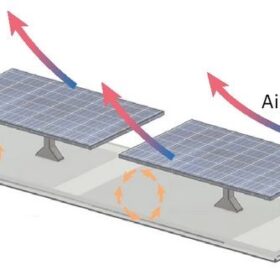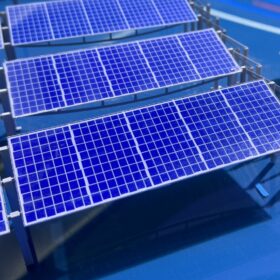Improving solar cell efficiency with upconversion nanoparticles
An international research group has developed a light upconversion system that can reportedly improve crystalline silicon solar cell efficiency by up to 0.87%. The technology consists of multilayer nanoparticles that act as near-infrared absorbers across different spectral ranges.
Panasonic powers UK factory with solar-driven hydrogen fuel cell generators
Panasonic has launched a solar-powered hydrogen fuel cell project at its factory in Cardiff, Wales, with the microwave assembly now operating on renewable energy.
Desalination system based on PVT-driven membrane distillation
Scientists have designed a PVT-driven direct contact membrane distillation system for off-grid applications. The system is intended for desalination purposes in remote areas.
Anti-soiling coating increases PV panel current in arid regions by 64.7%
Scientists in Egypt have created an anti-soiling coating for solar panels by mixing ethanol, deionized water, ammonium hydroxide and tetraethyl orthosilicate. They tested a coated panel outdoors for ten months and found that the panel showed a 64.7% higher current compared to reference modules without coating.
The Hydrogen Stream: Harvard researchers say H2 costs underestimated
Harvard University researchers say hydrogen costs are underestimated due to unaccounted storage and distribution variability across sectors, while Kore Infrastructure has told pv magazine that it aims to reach a levelized cost of hydrogen (LCOH) of between $1/kg and $2/kg.
Rooftop PV installations could raise daytime temperatures in urban environments by up to 1.5 C
New research shows that rooftop PV system may have “unintended” consequences on temperartures in urban environments. Rooftop arrays, for example, may potentially lower nighttime temperatures by up to 0.6 C.
Power-generating breakwaters for floating photovoltaics
Scientists from Singapore have designed new floating breakwaters integrating wave energy converters that can be used to reduce the impact of waves on offshore PV systems. Their analysis showed that the wave energy systems can achieve the highest additional power output when the wavelength is shorter.
New method to identify optimal floating PV sites
Researchers in Spain have created a novel method to select within a set of water bodies those where the investment in floating PV could be most beneficial. They combined geographic information systems, multi-criteria analysis, and intelligent optimization. The new approach reportedly results up to 8.4% better LCOE compared to conventional methods.
Using surplus PV power for seasonal underground thermal storage
Scientists have proposed a new system that uses surplus PV energy in the spring and the autumn to charge up underground thermal energy storage for later use in the summer and winter. They have simulated it on a school facility in Seoul, with a few optional configurations for thermal storage. Power savings were up to 39%.
The impact of semi-transparent solar modules on agrivoltaics yield
Researchers have conducted a field study across two growing seasons, growing different kinds of vegetables under three types of modules with 40%, 5%, and 0% transparency. Their work is the first replicated research experiment that evaluates module transparency in an irrigated vegetable field setting.















